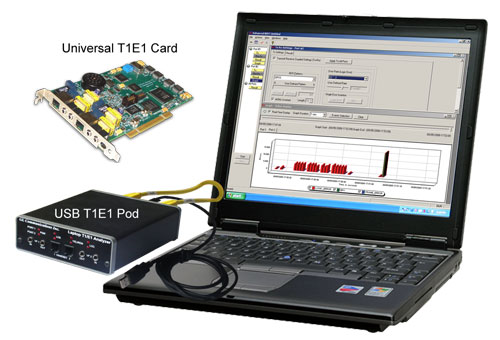Newsletter: GL Enhances T1 E1 Analyzer Products & Software
Welcome to GL's Newsletter covering the latest products, features, and enhancements to our versatile T1 E1 Analyzer product line. The software has been enhanced, now Version 5.32.

New applications introduced:
The new applications introduced into T1 E1 Version 5.32 are described briefly below:
- Protocol Identifier
- Classifies all HDLC based, ATM, and TRAU Protocols
- Classification of HDLC based protocols such as ISDN, SS7, PPP, FrameRelay, GSM, and so on
- Graphical Representation of the protocols and their stream configuration such as timeslot, hyperchannel, and subchannels, including customization of colors for each protocol
- Statistical information is also provided
- Filtering can be used to display the protocols of interest
- User can log the detected protocol, device and channel info into a specified path using Log Statistics
- SS1 Analysis & Emulation
- SS1 Dialer
- Allows users to setup and dial tone sequences that make up SS1 dial digits. The applications' interface includes options to set up/ place a call, and control mask & space frequencies and duration, and other parameters related to the digit dialer
- Allows a caller to dial a two- digit, three-digit dial code in burst and direct dial modes to a destination T1E1 channel; In addition it also features "Key & Send" option to allow any number of digits to be dialed
- Frequency can be set in the range of 2501 to 2699 for pulse tones, and 2301 to 2499 for guard tones, with duration of pulses upto 1000ms & 10000ms respectively
- Power levels can be varied from 3dBm to -27dBm
- Dialing can be performed to multiple destinations simultaneously using different instances of dialer
- SS1 Analysis
- Detects and analyzes tone sequences that makes up SS1 dial digits
- Sequences of pulse and guard tones are detected, decoded, and assembled into their corresponding dial digits
- The tone sequences are also verified for compliance against a "specification" parameter file which can correspond to published standards or user criteria
- Multi-Channel Audio Monitoring Bridge
- Listen to T1 E1 timeslots directly on your PC speaker or insert Microphone or Line-In signals into T1 E1 timeslots
- Provides a bridge between T1 E1 timeslots and single or multichannel sound card(s)
- Can also interwork with other "sound card aware" applications like Goldwave, Cool Edit, Adobe Audition, Audacity, Matlab, LabView and many others
- Audio can be transmitted or received using G.726 (40 kbps, 32 kbps, 24 kbps, or 16 kbps) codec format for direct insertion into T1 E1 timeslots, along with the usual u-law or A-law formats
Enhancements to the existing applications:
- Multiple Call Capture
- Added the option of prepending the "probe capture name" to the filename, as part of profile loading/saving
- Added direction indicator, 'E' or 'W', to SS7 capture filenames
- MAPS (Message Automation and Protocol Simulation)
- Encoding support for CSN based classes has been added
- ISDN - 5ESS variant has been added
- Additional information element for ISDN MLPP support
- WCS MLPPP Emulator
- MLPPP Echo Test Updates
New tab namely "Link Test" has been added - in MLPPP View
Hitherto we had Echo Test only at PPP level, now the echo test feature has been made available at MLPPP Bundle also - IP only compression in IPHC (IP header compression)
Hitherto there was support for IP/TCP, IP/UDP compressions in IPHC. Now there is support for only IP compression - Optional NCP negotiation
NCP negotiation has been made optional with user enabling/disabling the negotiation. This option is available in both PPP and MLPPP Simulation - Protocol Analyzers
- HDLC and PPP Protocol Analyzers support decoding of Cisco HDLC standard
- TRAU
- RIF(Request or Indication Flag) toggling has been implemented for AMR in TrauTool
- Formatted and updated the display of the fields in TRAU analyzer and detail view of TRAU PDA
- The file TrauSignallingInfo.h has been added to send the call details like Call Start Time and Call Duration to database
- INI Decode Option changed in ATM, UMTS, SaBit HDLC, and MLPPP Protocol Analyzers
- Windows Client Server
- Error Insertion
- Supports Auto Error Insertion with greater flexibility, with ability to turn on/off auto error insertion, to change error rates with enhanced command set
- Logic errors can now be inserted at a user-determined fixed or random rate; In Auto Insertion Mode, it is now possible to change the rate; Ex., "insert fixed", or "insert random"- can be any value between 10-2 and 10-9
- Ability to insert logic errors into specific timeslots
- Bulk delay features have been added
In addition to the above, there have been many minor modifications and bug fixes to the T1 E1 Software and for more details, please refer to the link what's new in the current version web page.
 Back to Latest News Page
Back to Latest News Page